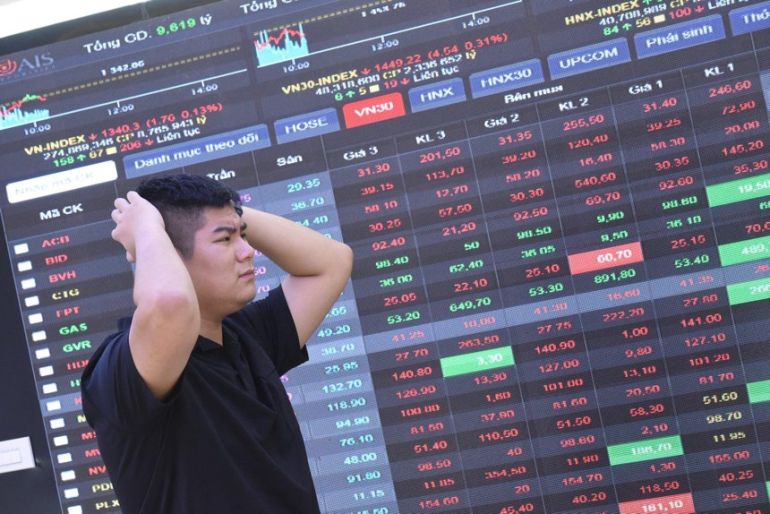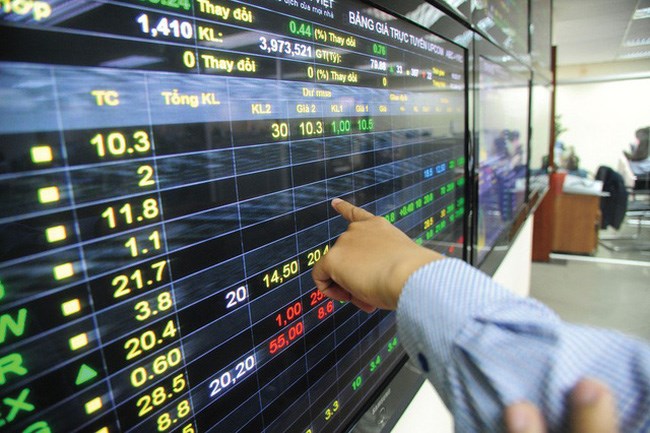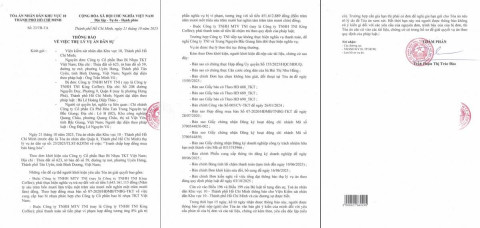The stock market faces increasing selling pressure, VN-Index sank into the red
- 11
- Business
- 17:29 04/09/2024
DNHN - The strong selling pressure across the market, especially in the blue-chip stocks, has caused the VN-Index to drop sharply, even falling below the 1,270-point mark at times.

The past trading week witnessed stagnation with a noticeable decline in liquidity due to cautious sentiment ahead of the long holiday. The VN-Index is currently in an accumulation trend around the 1,280-point mark, with technical indicators such as RSI, MACD, and -DI being pulled down, indicating the possibility of short-term upward movements in the near future.
According to Ms. Nguyễn Thị Mỹ Liên, Head of Analysis at Phú Hưng Securities (PHS), this phenomenon might be a temporary pause to absorb the supply at the old peak. Once the absorption process is completed, the market may have a significant opportunity to surpass the June peak (around 1,305 points) and continue its upward trend. Ms. Liên expects that this peak breakthrough could occur in September, and if the buying force is strong enough, the index could aim for the next resistance zone at 1,330-1,350 points before correction.
Mr. Lê Đức Khánh, Head of Analysis at VPS Securities, is also optimistic, believing that the Vietnamese stock market is facing a significant opportunity to surpass the psychological threshold of 1,300 points, potentially even in the first week of September.
However, the morning session on September 4th contradicted the experts' predictions. After four slight gains in a sequence of seven sessions with a narrow trading range, strong selling pressure caused the market to open in the red. The VN-Index plunged below the 1,270-point mark.
Although demand still focused on mid- and small-cap stocks, it was not enough to help these stocks escape the downward trend, such as VIX, VPB, SHB, and others. Meanwhile, the VN30 group is bearing the main burden of the market. After more than an hour of trading, the VN-Index narrowed its losses slightly and temporarily hovered around 1,275 points. However, the VN30 group continued to drop sharply, with only three stocks escaping the adjustment phase.
Looking at industry groups, most sectors saw losses, particularly the trio of banking, securities, and steel sectors, all trading below the reference level. A rare bright spot was real estate stocks, with some such as VHM, PDR, HHV, VCG, and HBC experiencing slight recoveries, although the gains were still limited.
Despite a more active market participation, the broad-based and significant selling pressure, particularly from the blue-chip stocks, made it difficult for the market to avoid a sharp decline.
At the end of the morning session, the HOSE recorded 60 gainers and 342 decliners, with the VN-Index down 12.94 points (-1.01%) to 1,270.93 points. Total trading volume reached 325.2 million units, with a value of 8,043.8 billion VND, up 47.62% in volume and 49.7% in value compared to the morning session on August 30th. Negotiated transactions contributed 26.23 million units, with a value of nearly 1,011 billion VND.
The VN30 group continued to increase pressure with a drop of more than 17 points, with 25 stocks declining and only four large stocks, including VHM, GAS, VNM, and BID, avoiding the adjustment phase. Among them, VHM ended the session up 1.3%, while the others only saw slight gains.
In the mid- and small-cap group, VIX remained the most active stock, but selling pressure caused it to continue to decline throughout the morning session. At the end of the session, VIX fell 2.1% with nearly 12.8 million units matched.
Industry groups also could not avoid the overall market adjustment trend. The trio of banking, securities, and steel sectors continued to be in the red, except for a few stocks such as BID and FTS, which managed to reverse with only around a 0.5% gain.
Real estate stock VHM remained a bright spot, maintaining a 1.3% gain, with liquidity in the top 5 leading the market, reaching nearly 8 million matched units. Infrastructure investment stocks such as HHV, VCG, LCG, and HBC also ended the session in the green.
On the HNX, the market also sank into the red with the HNX-Index dropping significantly. At the end of the morning session, the HNX recorded 39 gainers and 106 decliners, with the HNX-Index down 2.27 points (-0.96%) to 235.29 points. Total matched volume reached over 26.4 million units, with a value of more than 516 billion VND. Negotiated transactions added another 0.3 million units, with a value of 11.85 billion VND.
The HNX30 group saw a sharp decline, losing more than 8 points, with 27 stocks declining and only two, DHT and PLC, maintaining a green status, with only a 0.4% gain. SHS stock had the best liquidity in the market with nearly 5.4 million units matched, ending the session down 2.4% to the session's lowest price of 16,000 VND/share.
Real estate stock CEO matched 2.7 million units, holding the reference price of 16,100 VND/share. Meanwhile, NAG stood out with a strong increase of 7.1% to 12,000 VND/share, with 0.7 million units matched.
On the UPCoM, the market continued to decline slightly. At the end of the session, the UPCoM-Index fell 0.61 points (-0.64%) to 93.56 points. Total matched volume reached over 15.57 million units, with a value of 279.32 billion VND, with negligible negotiated transactions, not even reaching 2 billion VND.
The pair of oil and gas stocks remained active but could not escape the general adjustment trend. BSR dropped 2.1% with 4.95 million units matched, while OIL fell 2% with 1.36 million units matched.
Nhan Ha
Related news
# stock market

The "fierce" race for market share among securities companies
The Ho Chi Minh City Stock Exchange (HoSE) has just announced the third quarter trading market share, revealing the fierce competition in the securities industry.

How to understand the behavior of "manipulating the stock market"?
According to the provisions of Clause 3, Article 12 of the Law on Securities in 2019 and Clause 2, Article 3 of Decree No. 156/2020/ND-CP dated December 31, 2020 of the Government, it can be affirmed that the act of manipulating the stock market is one of the prohibited acts in securities and stock market activities.

Testing the "sandbox" model to diversify the Vietnamese stock market
The "sandbox" model to test new securities products will help select a number of securities companies and intermediary financial institutions with sufficient potential to pilot some structured products for the market.

Solutions to enhance information transparency of domestic listed companies
Experts from the Banking Academy's Institute of Scientific Research have proposed solutions to enhance the information transparency of domestic listed companies.
Đọc thêm Business
From New Year messages of World Leaders to the “new rules” of the Global economy in 2026
At a pivotal moment of transition, New Year messages from capitals such as Hanoi, Beijing, Washington and Paris reflect distinct priorities and strategic visions.
Connecting Leaders, Shaping the Future: Strategic Leadership Planning Meeting – CorporateConnections Hanoi A
"Your network is your most powerful flowing asset. It generates value, multiplies opportunities, and accelerates your influence across borders."
Innovative ESG enterprise: Trạm Xe Việt startup proposes solutions to build a green mobility ecosystem
As Vietnam commits to achieving Net Zero by 2050 and tightens emissions standards, the transportation sector faces unprecedented pressure to transform.
Deputy Prime Minister Nguyễn Chí Dũng: “The country’s major challenges weigh heavily on my mind — and we must resolve them together.
On the morning of November 26, 2025, Deputy Prime Minister Nguyễn Chí Dũng chaired a high-level working session at the National Innovation Center (NIC) in Hòa Lạc.
Unitsky String Technologies signs cooperation agreements with three Vietnamese partners, opening a new direction for smart mobility and sustainable development
The signing ceremony took place in Minsk, Belarus, on November 28, 2025.
Before the D‑day to abolish flat‑rate tax: Fear of technology and costs leave small traders struggling to adapt
From 1 January 2026 the flat‑rate tax regime will be abolished. Small business households will be required to declare tax based on actual revenue. MISA supports the transition with technology to help micro‑merchants adapt smoothly and transparently.
Vietnamese enterprises at a crossroads: the impact of a potential US–China deal
As the world closely monitors every shift in US-China relations, emerging signals of a strategic agreement between the two global powers are raising hopes for global economic stability.
HDBank: Impressive profit growth, leading in profitability and advancing international integration
Ho Chi Minh City Development Joint Stock Commercial Bank (HDBank, stock code HDB) announced its consolidated profit before tax for the first 9 months of 2025 reached VND 14,803 billion, marking a 17% increase year-on-year (YoY).
TNI King Coffee sued for over VND 5 Billion in unpaid debts
On October 21, 2025, the People’s Court of District 10 in Ho Chi Minh City officially accepted a civil lawsuit concerning a commercial contract dispute between TKT Vietnam Plastic Packaging Joint Stock Company and TNI King Coffee Co., Ltd.
VINASME and Jeonnam Technopark Sign MOU on technology cooperation, human resource training, and trade promotion
On October 15, 2025, in Hanoi, VINASME and Jeonnam Technopark (Korea) signed an MOU to promote trade, advance technology transfer, and develop human resources between enterprises of both nations.











